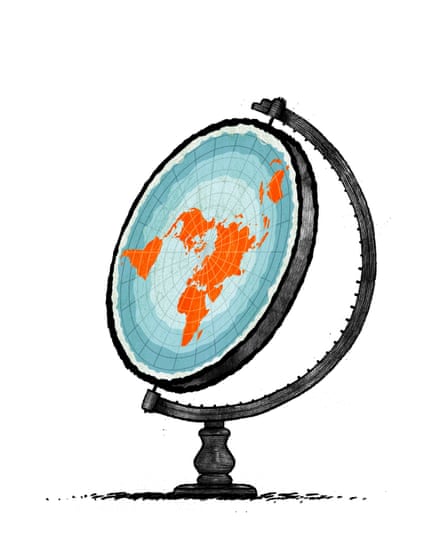“Nobody likes this uncomfortable feeling of being this tiny ball flying through space,” Mark Sargent, who believes that the world is flat, told the BBC the other day. I thought that was a revealing statement. I mean, don’t they? Personally, I don’t mind it. In fact, I’m not sure you can really feel it at all. Then again, I wouldn’t say I positively liked it either. I’m not against the world being flat. I’d be fine if it were. I’m content for the world to be whatever shape the world is. Unlike Mark Sargent, I don’t have a preference.
The remark gives an interesting insight into his approach. I’d say, if you’re trying to convince people of something that flies in the face of scientific orthodoxy, it’s advisable not to let slip that, before you started your researches, you had a huge emotional preference for what you ended up concluding. It may lead people to believe you’ve attached more weight to evidence supporting your theory than to evidence refuting it. And, let’s be honest, people are going to be pretty ready to believe that anyway because you’ve been trying to convince them that the world is flat. And it isn’t.
But what do I know (other than that the world is round)? Mark Sargent has 43,415 subscribers to his “Flat Earth” YouTube channel. He’s an extremely successful advocate of a conclusively disproved theory. This guy could flog the Amstrad Emailer. And he obviously reckons the notion that there’s something slightly off-putting about the planet being a ball is a key selling point.
Sargent was being interviewed at the first annual Flat Earth International Conference, held just over a week ago in North Carolina, as part of a light-hearted little BBC website package on the subject. “Let’s take a wry look at this tiny subculture of harmless eccentrics,” was the tone. “Why do people still think the Earth is flat?” was the title.
The answer seemed to be that they just used their gut instinct and common sense: it looks flat – or flattish, flat with a few bumps – so it must be. Marilyn Teed, who’d travelled to the conference from Pennsylvania (presumably without the help of GPS), explained how she knew: “I went down to the seashore, down New Jersey, and I did my own testing… you take a straight edge and you go from one end and you follow the horizon of the ocean and… it’s flat.”
Assuming no access to information other than the evidence of her own eyes, that’s a perfectly reasonable conclusion. You’d need to either have an instinctive genius for astronomy, or be as obsessively drawn to spheres as Mark Sargent is repelled by them, to stand on a bit of the world and decide it seems flat only because it’s actually a tiny, imperceptibly curved part of an unimaginably massive ball. But, in fact, she has had access to other information. As part of her research, she says she’s “watched over 50 hours of video”. Mainly adaptations of Terry Pratchett books, presumably.
The only thing that seriously bothers me about this is that it was the first annual Flat Earth International Conference. This isn’t a regular event held by a dwindling band. These people’s crazy notion is, albeit to a tiny extent, on the rise again. As the conference’s website puts it: “Like you, we grew up believing in a heliocentric globe-Earth model,” (translation: spherical Earth orbiting sun – like in, say, reality) but “After extensive experimentation, analysis, and research, we have come to know that the truth of our cosmology is not that which we’ve been told.” It also states chillingly that “every experiment ever conducted to prove even the simple spin of the Earth has failed”.

That’s not true. What “extensive experimentation”? People have been up in a bloody rocket, looked out the window and seen that the Earth is round. There are loads of photos. Yet the website seems so plausible, so reasonable. It’s a neat, slightly boring webpage, as if it’s the rules for the election of officers of the Chartered Institute of Personnel and Development. It’s the blandest smelling horseshit you can imagine. Why is it there? Why do they think that? Why do they want to convince people? Why are people convinced? The Earth is round! We found that out ages ago! We’ve got to move on.
I don’t really think significant numbers are going to start doubting the Earth’s shape. What worries me is how, in this bewildering internet age, every fact, however apparently undeniable, has the potential to become a subject for debate. The canniest thing Mark Sargent said in his interview was “Don’t take my word for it – I could be a mental patient recently released from an institution.”
How admirably open-minded of him! But what he’s implying is: so could anyone. You can’t take anybody’s word for anything. The discerning thinker disbelieves everything and then makes up his or her own mind on the basis of looking out to sea. It’s a clever line for him to take, because the Earth being round is a classic example of an issue where, unless you’re an astronaut, you sort of do have to take somebody’s word for it.
The recent explosion of weirdly unfocused scepticism is, I suppose, a natural response to this nasty internet-contaminated era. Accusations of fake news abound and are hugely worsened by, for example, Donald Trump’s delusional mixture of lying and denial, and his determination to discredit all the most reliable news sources. Recent revelations that thousands of the accounts tweeting enthusiastically about Brexit were probably malign Russian cyborgs further undermines the credibility of anything but the evidence of our own eyes.
Unfortunately, this boundless doubting could take us right back to the stone age – and not in a time machine we’ve invented. The accumulation and advance of human learning, and therefore of civilisation, relies on things being written down and subsequently believed. It’s built on trust.
A safety-first, unquestioning scepticism about absolutely everything could lead to the thoughtless discrediting, and chucking out, of huge swaths of our collective achievements. I don’t really know what we should do about it, but neither can I put a ceiling on how much it’s appropriate to worry.
After all, out there somewhere are thousands of people once more insisting the Earth is flat. And they know how to set up a website. And I don’t.

